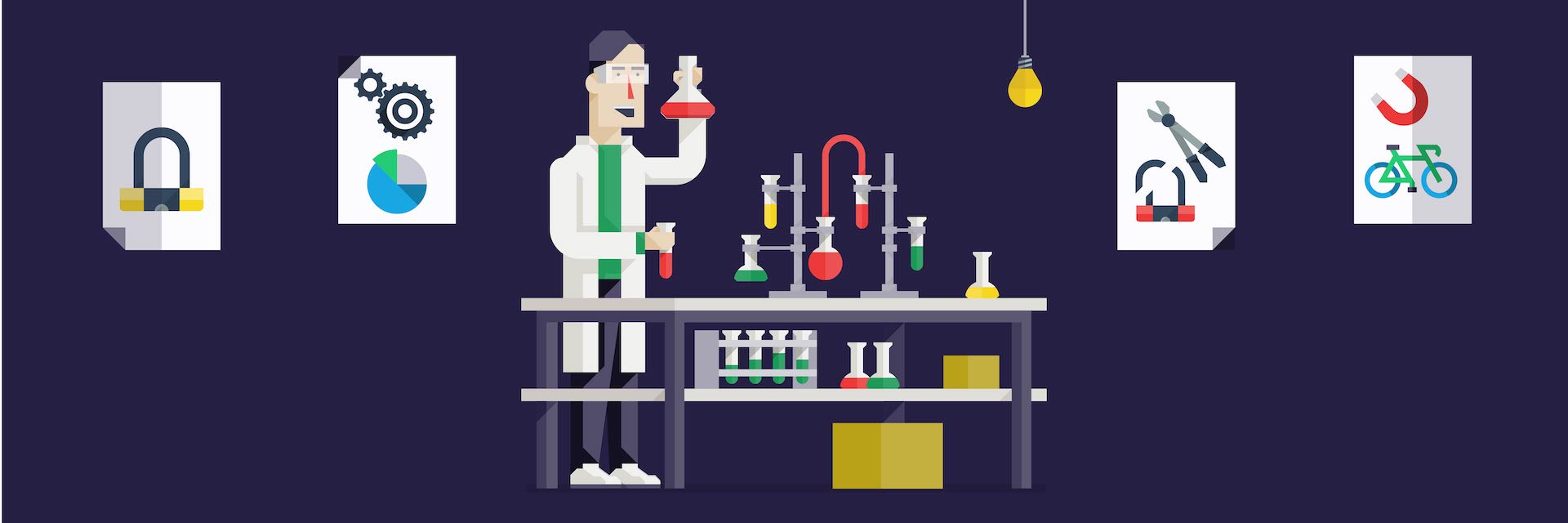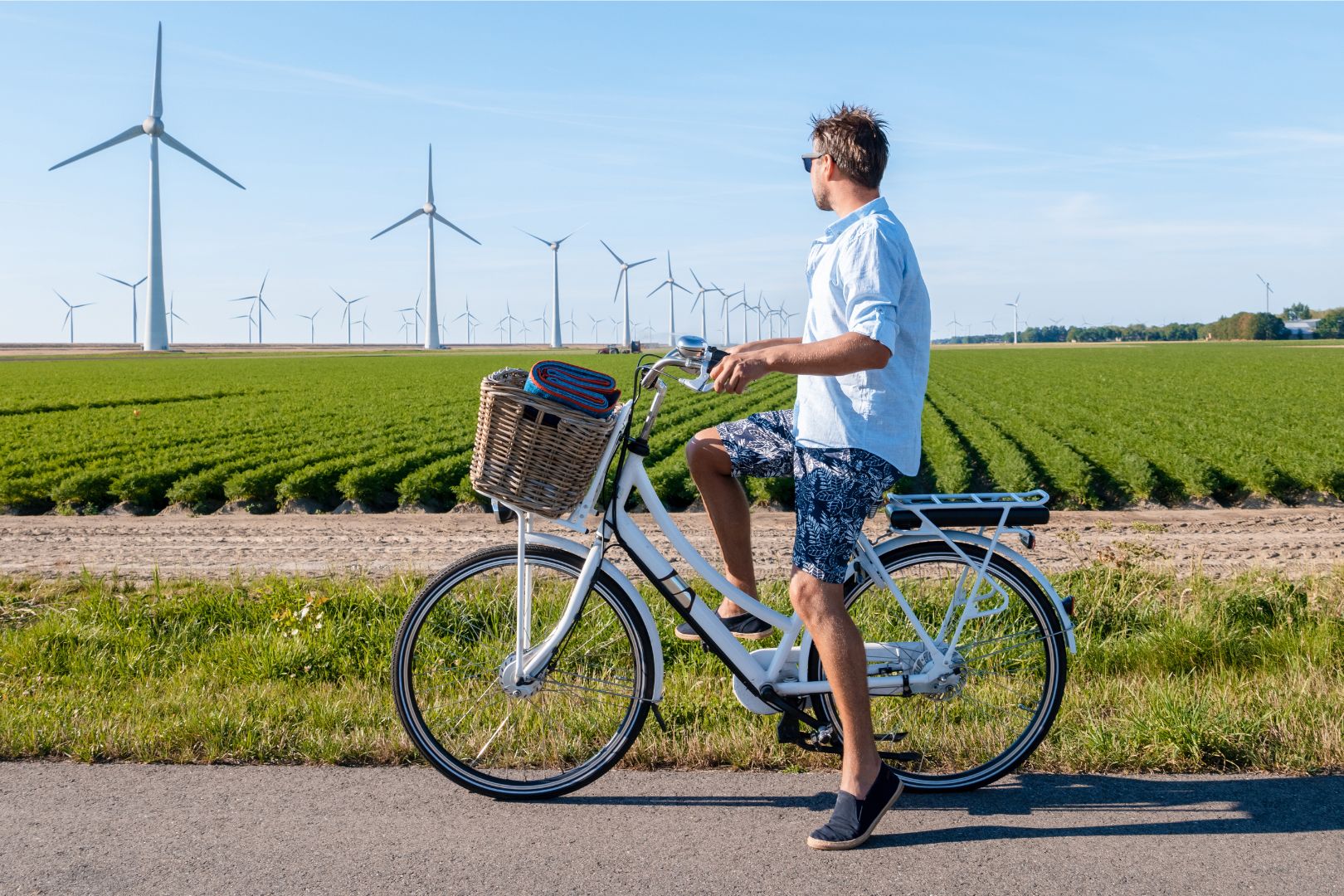
Frame sizes: The ultimate guide
The ultimate guide for for choosing the right bike size for you. What is the bike frame size and how to pick the right one for different types of bikes (city bike, road bike, mountain bike, kids bikes and more).
Are you looking for a quick measurement? Simply use the tool to calculate your estimated frame size!

Recommended frame size

Alternatively, if you'd like to know every detail on frame size measurement, read on below...
What size of bike is right for me?
You wouldn’t believe how hard it is to answer this question correctly. We did all the work for you though, and behold, you are about to read the ULTIMATE BIKE SIZING GUIDE.
“How many inches are the wheels?”
– the most common MISTAKE people make when asking about bike sizes
You may notice that in our filters, we have this sizing for choosing the right bike:
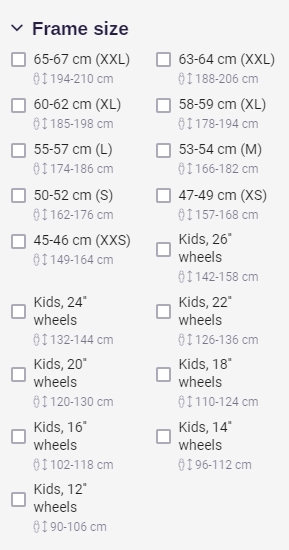
BikeFair filters on our marketplace for choosing the right bike
Ssssh! Let us tell you a secret though: this is not 100% universally optimal. Why?
Because:
- People are different
- Bikes are different.
- Relationships between people and bikes are different.
Wut?
- Overall body height is one thing. But even if you are say 175 cm tall, your legs can be anywhere between 0 cm and 150 cm. (Ok, 150 cm legs and then head would be pretty weird…). Anyway, leg (and even arm) length makes a big difference for cycling.
- Mountain bikes, tricycles or regular comfortable city bikes all have different purpose, and hence need to be built differently. That of course brings variety in sizing.
- It also makes a difference if you use a road bike for long distance workouts or you turn it into a fixie and use it to stroll the city streets. In other words, it depends HOW you use your bike (and how you want to feel when doing that), too.

Happy guy jumping in the trousers
Let’s stay smart though.
Unless you’re:
- picking a top-class performance road or mountain bike, or
- you REALLY care about your own comfort (e.g. for medical reasons – having trouble with your back or legs), bike sizing is actually quite simple and you probably don’t need to spend hours with measuring calculations.
On the other hand, if you’re a performance biker or have severe medical issues, it might just make sense to invest extra time and effort in getting a perfectly fitting bike. Even if that’s the case for you, picking the right bike size is not the hardest thing. You’ll mainly need to do a proper “bike fitting” (adjust the bike to your needs) afterwards – that is what makes a lot of difference. We’d recommend a performance bike shop for that (that is, a bike shop offering a lot of futuristic-looking race or mountain bikes), those tend to have the equipment and staff well educated on this topic. Feel free to reach out to us and we’ll help you find one.
Speaking of the regular bike SIZING though – what should you look for?
What should you measure?
Need one thing to remember? Unless you are buying a kid’s bicycle, DO NOT THE PICK BIKE SIZE BASED ON WHEEL SIZES – it is similar to picking a bus based on it’s colour. There’s no real logic in that.
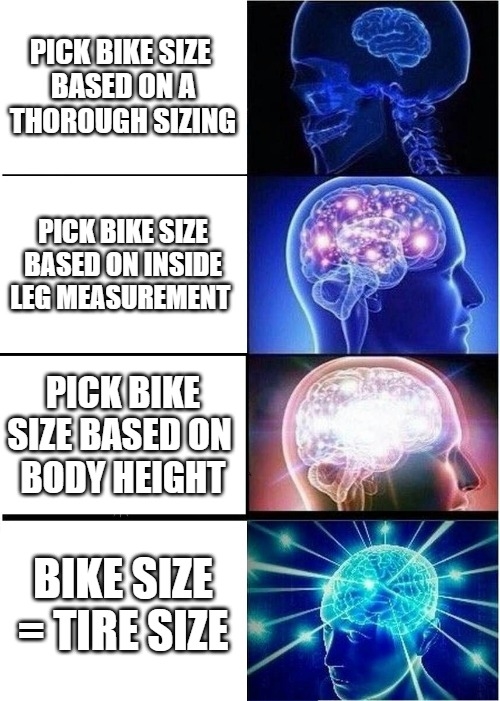
Choose bike size steps
This is a seat tube length or a “frame size”:
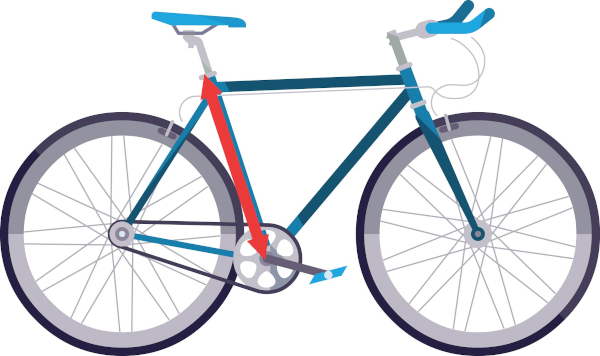
Detailed part of the bike1
Frame size (seat tube length) is a decent size indication of a bike fit for person.
This is wheel (or tire) size:
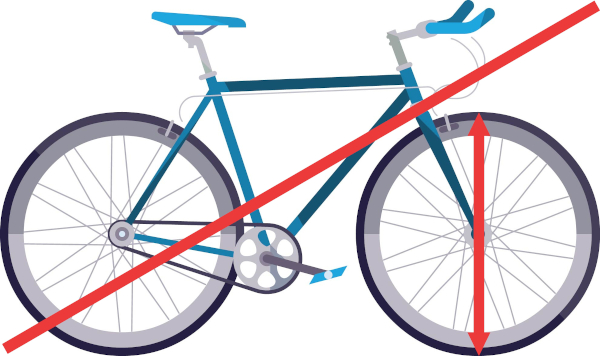
Detailed part of the bike2
Only very rarely the appropriate size of bikes is given by wheel size. (Namely, kids bikes are classified like that.)
For most cases, you should compare your LEG INSEAM (or TOTAL BODY HEIGHT if you really don’t care that much) to the seat tube length (“FRAME SIZE”).
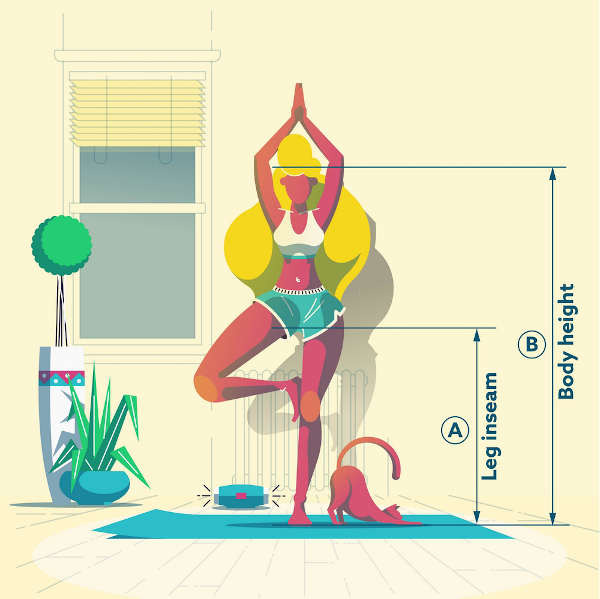
Animation of woman doing joga
WHY? Because then you are comparing comparable lengths. When sitting on a bike, your leg inseam (“leg length”) will in reality be stretched between the seat and the pedal. And because leg inseam (A) and body height (B) are typically similar for many people, you can extrapolate the B/A and assign “correct frame sizes” to certain body heights.
The rest of the bike is measured and built in a similar way depending on the bike’s purpose. So on city bikes, the top frame tube length will be in certain ratio to the seat tube length so that you don’t need to stretch too much. Whereas on road bikes the ratio (and frame shape) will be different to ensure you are in aerodynamic position when riding the bike. This is how it works:

Positions, how can you sit on the bike
So:
- First thing is choosing the right bike type. (Not sure how to do that? Check our guideline!)
- Second step is choosing the right bike size.
- The last thing then is adjusting ("fitting") the bike to your specific needs.
Choosing the right size is important, but it's not THAT much of a big deal because you can do a huge difference with the final "bike fitting" adjustments. Want more detailed information? See the box at the bottom of this articled for advanced info.
What’s the magic formula then?
Well, we need to distinguish between three main types of bikes: city bikes (also valid for classic Dutch type – “omafietsen”, and other with straight posture when cycling), road bikes and mountain bikes.

Picture of couple, who's riding a city bike
City bikes sizes
| (1) Your leg inseam? | …or (1) Your height? | (2) Find bike frame size | |
| Inseam | Height | Frame - cm | Frame - standard |
| 65 - 69 cm | 152 - 164 cm | 45 - 46 cm | XXS |
| 69 - 73 cm | 157 - 168 cm | 47 - 49 cm | XS |
| 73 - 76 cm | 162 - 176 cm | 50 - 52 cm | S |
| 77 - 80 cm | 166 - 182 cm | 53 - 54 cm | M |
| 80 - 84 cm | 174 - 186 cm | 55 - 57 cm | L |
| 84 - 88 cm | 178 - 194 cm | 58 - 59 cm | XL |
| 88 - 91 cm | 185 - 198 cm | 60 - 62 cm | XL |
| 92 - 95 cm | 188 - 206 cm | 63 - 64 cm | XXL |
| 95+ cm | 194+ cm | 65 - 67 cm | XXL |
*Less than ~155 cm tall? Check out the kids sizes. Same bikes, but cheaper!
City bikes - INCHES
| (1) Your leg inseam? | …or (1) Your height? | (2) Find bike frame size | |
| Inseam | Height | Frame - inches | Frame - standard |
| 25,7” - 27,2” | 4' 11" - 5' 4" | 18” | XXS |
| 27,2” - 28,7” | 5' 1" - 5' 6" | 19” | XS |
| 28,7” - 30,1” | 5' 3" - 5' 9" | 20” | S |
| 30,1” - 31,6” | 5' 5" - 5' 11" | 21” | M |
| 31,6” - 33,1” | 5' 8" - 6' 1" | 22” | L |
| 33,1” - 34,5” | 5' 10" - 6' 4" | 23” | XL |
| 34,5” – 36,0” | 6' 0" - 6' 5" | 24” | XL |
| 36,0” - 37,5” | 6' 2" - 6' 9" | 25” | XXL |
| 37,5”+ | 6' 4"+ | 26” | XXL |
*Less than ~4’12” tall? Check out the kids sizes. Same bikes, but cheaper!
Falling in between sizes? Then remember the smaller the frame, the more dynamic/faster riding style it supports, while larger frame size provides you with more comfort while riding.
Aside from the table, you can also use the commonly know formula:
Leg inseam (A) * 0,68 = your frame size
...but why bother, you got the table above ?

Woman with helmet passing by on the bike
Search city bikes
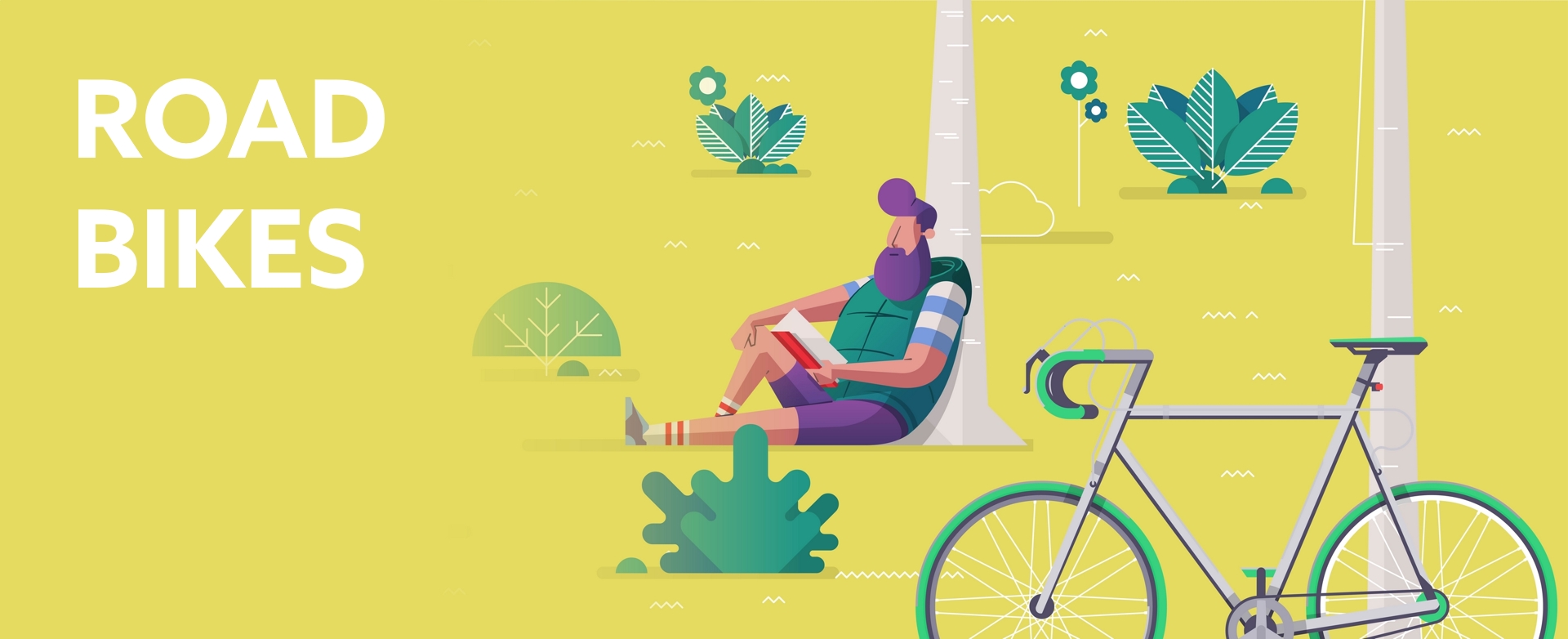
Picture of man, sitting under tree with his road bike
Road bikes sizes
Before getting into the details here, a major disclaimer: there is a whole "science" of bike geometry (related to bike fitting, as already mentioned above) that can throw you off easily. Buying your first bike? (Here can be a helpful article of us). Take it all with a pinch of salt (including this article and table below!) and just try and find a bike that'll roughly fit you and mainly that you will feel well on. That could take a couple tries, no way around this. (PRO TIP: Follow the advice of manufacturers, they usually know what/who exactly is the bike made for). Once you start actually using it, you'll learn what actually works and what doesn't for you personally.
Looking to make things harder for yourself right from the beginning (or just want a sneak peek into what lies ahead?) Check this video about bike geometry.
| (1) Your leg inseam? | …or (1) Your height? | (2) Find bike frame size | |
| Inseam | Height | Frame - cm | Frame - standard |
| 64 - 67 cm | 140 - 150 cm | 45 - 46 cm | XXS |
| 67 - 71 cm | 144 - 157 cm | 47 - 49 cm | XS |
| 71 - 74 cm | 153 - 166 cm | 50 - 52 cm | S |
| 74 - 78 cm | 162 - 174 cm | 53 - 54 cm | M |
| 78 - 82 cm | 170 - 183 cm | 55 - 57 cm | L |
| 82 - 85 cm | 178 - 188 cm | 58 - 59 cm | XL |
| 85 - 89 cm | 184 - 198 cm | 60 - 62 cm | XL |
| 89 - 93 cm | 193 - 205 cm | 63 - 64 cm | XXL |
| 93+ cm | 199+ cm | 65 - 67 cm | XXL |
*Less than ~155 cm tall? Check out the kids sizes. Same bikes, but cheaper!
Road bikes - INCHES
| (1) Your leg inseam? | …or (1) Your height? | (2) Find bike frame size | |
| Inseam | Height | Frame - inches | Frame - standard |
| 25,0” - 26,4” | 4' 7" - 4' 11" | 18” | XXS |
| 26,4” - 27,9” | 4' 8" - 5' 1" | 19” | XS |
| 27,9” - 29,3” | 5' 0" - 5' 5" | 20” | S |
| 29,3” - 30,7” | 5' 3" - 5' 8" | 21” | M |
| 30,7” - 32,2” | 5' 6" - 6' 0" | 22” | L |
| 32,2” - 33,6” | 5' 10" - 6' 2" | 23” | XL |
| 33,6” - 35,0” | 6' 0" - 6' 5" | 24” | XL |
| 35,0” - 36,4” | 6' 3" - 6' 8" | 25” | XXL |
| 37,2”+ | 6' 6"+ | 26” | XXL |
*Less than ~4’12” tall? Check out the kids sizes. Same bikes, but cheaper!
Falling in between sizes? Then remember the smaller the frame, the more dynamic/faster riding style it supports, while larger frame size provides you with more comfort while riding.
Aside from the table, you can also use the commonly known formula:
Leg inseam (A) * 0,7 = your frame size
.
..but why bother, you got the table above ?

Man racing in the city
Search road bikes
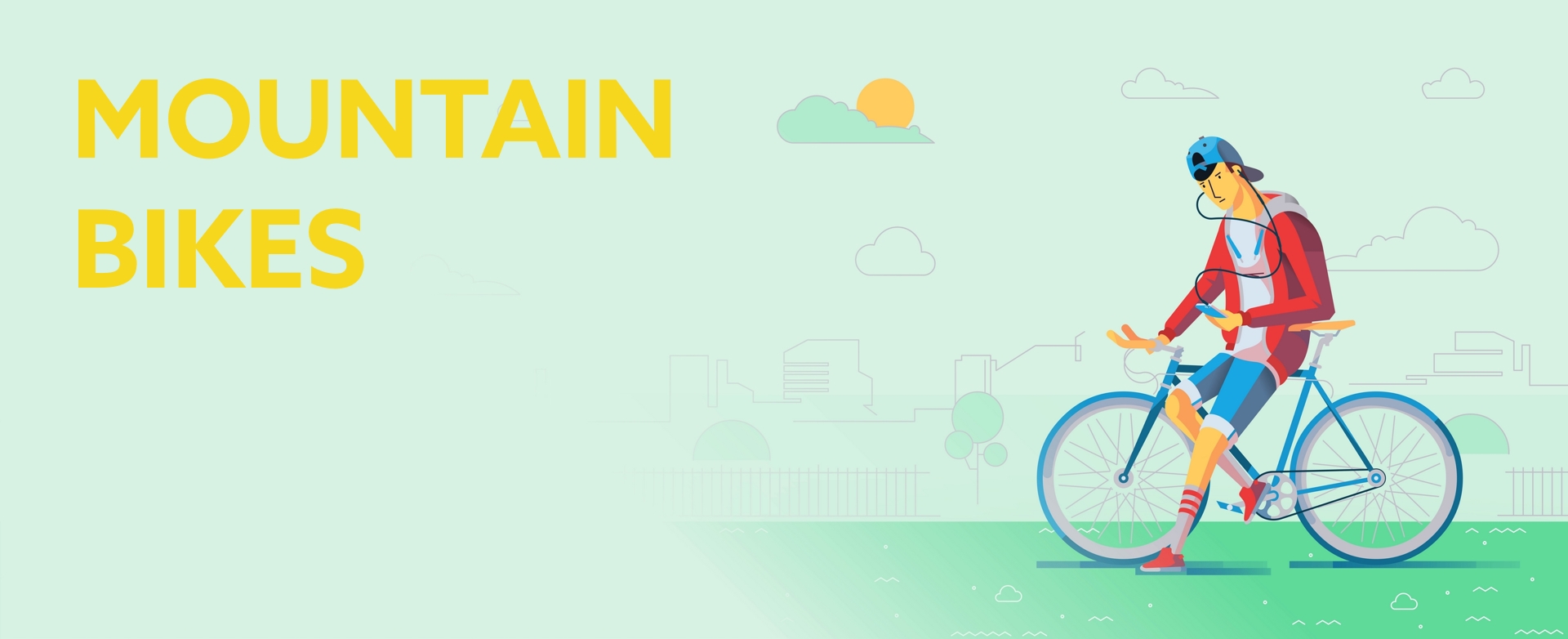
Young lad sitting on bike with phone
Mountain bikes sizes
| (1) Your leg inseam? | …or (1) Your height? | (2) Find bike frame size | |
| Inseam | Height | Frame - cm | Frame - standard |
| 55 - 59 cm | 150 - 160 cm | 32 - 34 cm | XXS |
| 59 - 64 cm | 150 - 165 cm | 35 - 36 cm | XS |
| 64 - 68 cm | 155 - 170 cm | 37 - 39 cm | S |
| 68 - 72 cm | 165 - 175 cm | 40 - 41 cm | S |
| 72 - 77 cm | 170 - 180 cm | 42 - 44 cm | M |
| 77 - 81 cm | 175 - 185 cm | 45 - 46 cm | M |
| 81 - 85 cm | 180 - 190 cm | 47 - 49 cm | L |
| 85 - 90 cm | 184 - 193 cm | 50 - 52 cm | L |
| 90 - 94 cm | 187 - 196 cm | 53 - 54 cm | XL |
| 94 - 97 cm | 190 - 200 cm | 55 - 57 cm | XL |
| 97+ cm | 195+ cm | 58 - 59 cm | XXL |
*Less than ~155 cm tall? Check out the kids sizes. Same bikes, but cheaper!
Mountain bikes - INCHES
| (1) Your leg inseam? | …or (1) Your height? | (2) Find bike frame size | |
| Inseam | Height | Frame - inches | Frame - standard |
| 21,6” - 23,3” | 4' 11" - 5' 2" | 13” | XXS |
| 23,3” – 25,0” | 4' 11" - 5' 4" | 14” | XS |
| 25,0” - 26,7” | 5' 1" - 5' 6" | 15” | S |
| 26,7” - 28,4” | 5' 4" - 5' 8" | 16” | S |
| 28,4” - 30,2” | 5' 6" - 5' 10" | 17” | M |
| 30,2” - 31,9” | 5' 8" - 6' 0" | 18” | M |
| 31,9” - 33,6” | 5' 10" - 6' 2" | 19” | L |
| 33,6” - 35,3” | 6' 0" - 6' 3" | 20” | L |
| 35,3” - 37,1” | 6' 1" - 6' 5" | 21” | XL |
| 37,1” - 38,8” | 6' 2" - 6' 6" | 22” | XL |
| 38,8”+ | 6' 4"+ | 23” | XXL |
*Less than ~4’12” tall? Check out the kids sizes. Same bikes, but cheaper!
Falling in between sizes? Then remember the smaller the frame, the more dynamic/faster riding style it supports, while larger frame size provides you with more comfort while riding.
Aside from the table, you can also use the commonly know formula:
Leg inseam (A) * 0,58 = your frame size
...but why bother, you got the table above ?
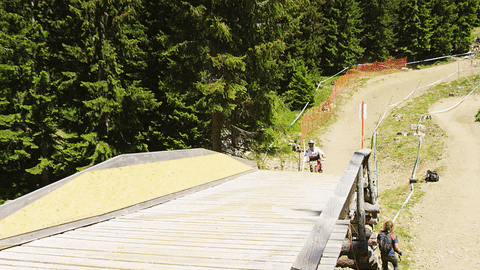
Mountain bike jump
Search mountain bikes
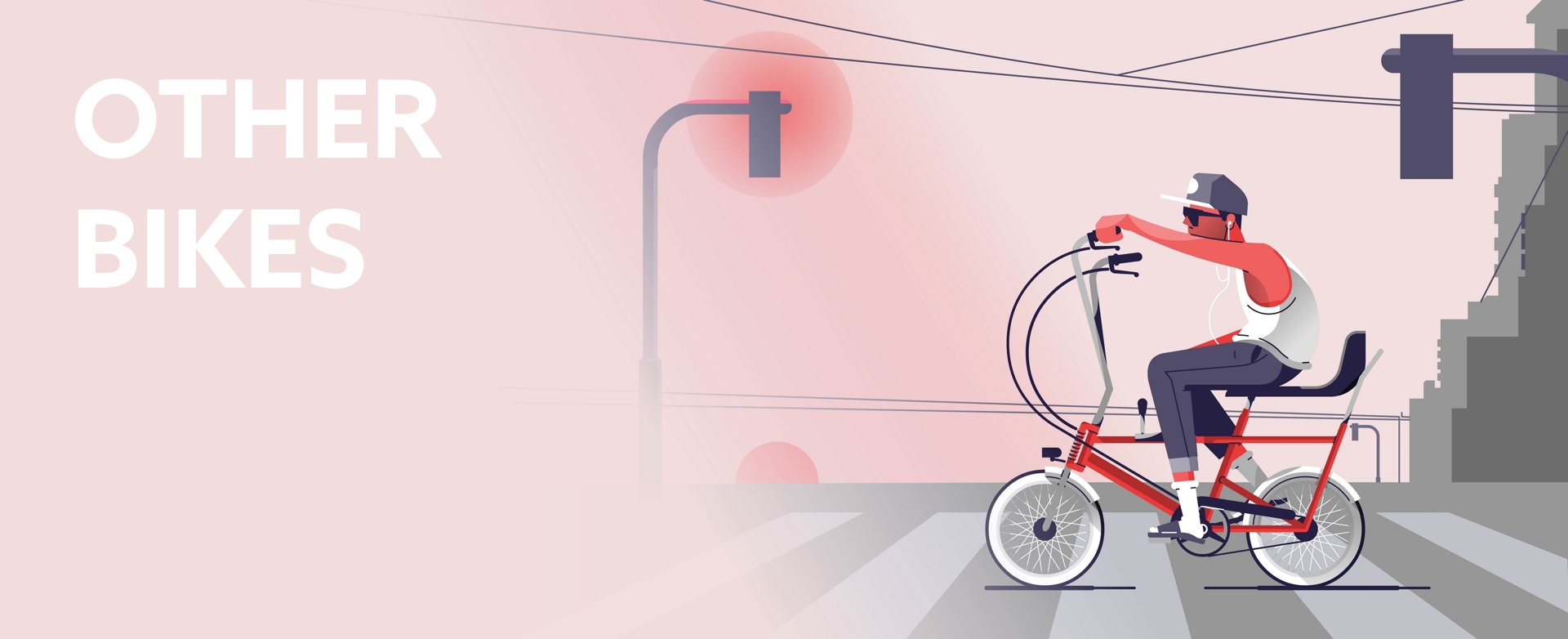
Picture of bmx bike
Special cases
There's a couple of special bike types which have their sizes set in a different way: most notably kids bikes, folding bikes and BMX. Aside from those, there's a plenty of other bike types with a similar issue, but we'll devote a separate article to those peculiar (read: really REALLY interesting) bikes.
Kids bikes sizes
Kids bikes are as the only bike type classified by wheel size. It is because the frames are so small that different wheel sizes simply make bigger size steps than the frames.
| (1) Body height | …or (1) age | (2) Find bike wheel size | |
| Height - cm | Height - inches | Age | Wheel size - inches |
| 80 – 100 cm | 2' 7" - 3' 3" | 1 - 4 | 10” |
| 85 – 105 cm | 2' 9" - 3' 5" | 2 - 5 | 12” |
| 95 – 110 cm | 3' 1" - 3' 7" | 3 - 5 | 14” |
| 105 – 115 cm | 3' 5" - 3' 9" | 4 - 6 | 16” |
| 110 – 125 cm | 3' 7" - 4' 1" | 5 - 8 | 18” |
| 120 – 135 cm | 3' 11" - 4' 5" | 7 - 9 | 20” |
| 125 – 140 cm | 4' 1" - 4' 7" | 8 - 10 | 22” |
| 135 – 145 cm | 4' 5" - 4' 9" | 9 - 12 | 24” |
| 140+ cm | 4' 7"+ | 1 1+ | 26” |

Young lady parking kids bike like a pro
Search kids bikes
Folding bikes sizes
Folding bikes are the easiest to size – manufacturers typically stick to the “one size fits all” approach. And while folding bikes DO come in different wheel sizes (16, 20, 24, 26 and 27.5″ with 20” being the most popular), this doesn’t reflect in variability for user height. In other words:
We even put it in a table for those who skip the text:
Folding bikes - CM
| (1) Your leg inseam? | …or (1) Your height? | (2) Frame size |
| 55 - 95+ cm | 150 – 210+ cm | Folding bike frame sizes are universal. And while wheel sizes differ, they do not set ideal user height |
Folding bikes - INCHES
| (1) Your leg inseam? | …or (1) Your height? | (2) Frame size |
| 21" - 37"+ | 4' 11" - 6' 10"+ | Folding bike frame sizes are universal. And while wheel sizes differ, they do not set ideal user height |
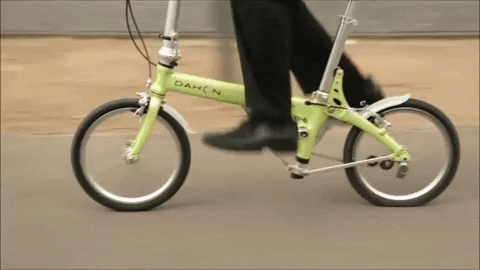
Green folding bike ride through the city
Search folding bikes
BMX sizes
BMXs size is measured differently – it is the top tube size. Top tube is the top part of the frame that connects the head tube (front of the bike) with the seat tube.
Wheel sizes also play a role, BMX bikes come in 12-24” wheel sizes (20” being the standard). Typically, 16 inch wheels go for kids BMXs, 18 inch wheels are for small freestyle bikes, 20 is the standard for most BMX bikes and 24 is usually only for cruiser bikes. But just like with “ordinary” bikes, you shouldn’t pick BMX based (only) on a wheel size.
| (1) How tall are you? | (2) Frame size of a BMX | |||
| Height - cm | Height - inches | Inches | cm | Standard |
| 120 – 130 cm | 3' 11'' - 4' 3'' | 15” - 16,5” | 38 – 42 cm | Micro Mini |
| 130 – 140 cm | 4' 3'' - 4' 7'' | 16” - 17,5” | 41 - 44 cm | Mini |
| 140 – 150 cm | 4' 7'' - 4' 11'' | 17” - 19” | 43 - 48 cm | Mini/Junior |
| 150 – 160 cm | 4' 11'' - 5' 2'' | 18,5” - 20” | 47 - 51 cm | Junior |
| 160 – 170 cm | 5' 2'' - 5' 6'' | 19,5” - 21” | 50 - 53 cm | Expert/Pro |
| 170 – 180 cm | 5' 6'' - 5' 10'' | 20,5” - 21,5” | 52 - 55 cm | Pro XL |
| 180+ cm | 5' 10''+ | 21” - 22” | 53 – 56 cm | Pro XXL |
Aside from a general fit, you should also consider what you want to use the bike for. Just like with other bikes, the smaller the size, the more agile you will be, but the less stability will the bike provide. This is how it translates to a specific use of your BMX:
Park
Park riders typically prefer more responsive bikes. So shorter top tube, chain stay and a steeper head tube angle. Pick slightly smaller size from our table above.
Trails
Trail/dirt riders usually like bigger and more stable bikes. So, a longer top tube, chain stay and a slacker head tube angle. This should give your ride more stability and comfort even on large jumps.
Street
Street riders typically pick something in between, depending on their personal preference. Street BMXs are typically a bit sturdier to endure grinding and flat landings.
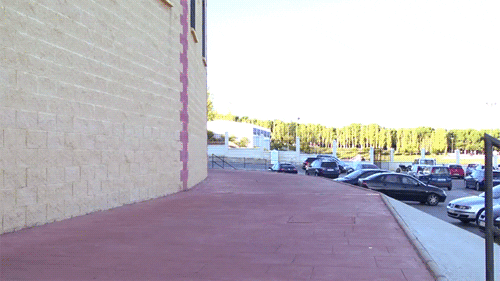
BMX trick jump on and off the wall
Search BMX
Fitting the bike
Frankly, choosing your size is the easy part. Once you’re through with that, you need to actually FIND IT (which is sometimes the hardest thing on the whole process – you can start with our marketplace ?) and TEST IT properly. This article will tell you more about how to do that.
Once you actually got the bike, the real “alchemy” starts – FITTING YOUR NEW BIKE specifically to your needs. That means adjusting all its movable parts and eventually replacing those that are easily replaced so that the bike fits you like a glove. We’re preparing an article on this topic, but let us say one thing here: as long as you are in the right ballpark with the size,
you can do more “magic” with proper fitting than with spending eternity with picking/searching for the super-optimal size.
ADVANCED BIKE FITTING BOX
If you spend a lot of time on your bike – think ca 2+ hours per average ride/workout, or 12+ hours per week – or for any reason you REALLY care about having your bike perfectly fit you, these are the basics.
Key things to consider when fitting your bike are CONTACT POINTS. Contact points are places where you (rider) come in contact with the bike.
Depending on a bike type, your preferred riding style (position) and your body constitution, you need a bike with different distances and angles between the contact points. This is a good illustration of how the principle works:
There are many things you should consider (and eventually set up) on a bike to achieve the optimal fit: saddle height, horizontal position in the seat post (“fore/aft position”) and angle, headset height, angle, stem length etc.
Then you can use different equipment based on your setup – for instance, different seat types (shape, hardness) or handlebar types fit different riding styles. As mentioned above though – those things are mainly important for advanced bikers and/or cyclists with specific needs.
There’s a whole “science” around bike fitting though, so we’ll get in more detail in a different article.
We already know how to choose the best bike for our size. So, what are we waiting for? Browse our selection of second-hand bikes in the Netherlands. You won't be disappointed!
Good luck and have fun! ?
FIND OUT MORE:
How to choose (and check) a second-hand bike
Bike locks: How do I choose the right one?! The ultimate guide.
Frame number: The real hero of the bike theft battle & how it can save your bike
Anti-theft 1.0: The basics of bike locking
The Science of Bike Locking: Outsmart the Thieves!


